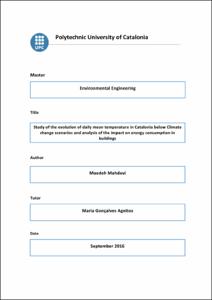Mostra el registre d'ítem simple
Study of the evolution of daily mean temperature in Catalonia below climate change scenarios and analysis of the impact on energy consumption in buildings
| dc.contributor | Gonçalves Ageitos, María |
| dc.contributor.author | Mahdavi, Maedeh |
| dc.contributor.other | Universitat Politècnica de Catalunya. Departament d'Enginyeria del Terreny, Cartogràfica i Geofísica |
| dc.date.accessioned | 2017-01-26T15:57:20Z |
| dc.date.available | 2017-01-26T15:57:20Z |
| dc.date.issued | 2016-10-24 |
| dc.identifier.uri | http://hdl.handle.net/2117/100141 |
| dc.description.abstract | Higher availability of future climate data sets, generated by regional climate models (RGMs) with fine temporal and spatial resolutions, improves and facilities the impact assessment of climate change. Due to significant uncertainties in climate modelling, several climate scenarios should be considered in the impact assessment. Climate change is expected to decrease heating demand, increase cooling demand for buildings, and affect outdoor thermal comfort. All these indicators are important when it comes to energy management and energy consumptions of different sectors. In particular studying the temperature variations of a region during a specific period will provide an estimation of the change’s trend and could be used as a measure for design energy management plans, energy saving, environmental friendly infrastructures and reduce the greenhouse gas emissions. In this work, changes in residential Heating Degree Days (HDD) and Cooling Degree Days (CDD) for historical (1981‐2005) and future (2031‐2050) periods in Catalonia and Barcelona region are studied. The study was done using Cosmo Climate Limited‐area Modelling Community (COSMO‐CLM) regional climate model and Max Planck Institute for Meteorology (MPI) model, which is based on a coupled ocean‐atmosphere GCM. This study analyses the annual and seasonal CDD, HDD and temper ature values over Catalonia and Barcelona by utilizing daily mean temperature series during the mentioned period from the EURO‐CORDEX project. The values of CDD and HDD have been calculated from a base temperature (for HDD is 18 °C, and for CDD is 22 °C). The result of future analysis shows that Barcelona will experience less heating degree‐days and more cooling degree‐days in the considered period (annual analysis). The same cannot be said for Catalonia case since each model shows a different trend and it is difficult to make a conclusion. The historical analysis shows that during the period of study, Barcelona’s annual average of CDD has been increased while HDD has been decreased. For Catalonia, the annual HDD has decreased and the CDD has increased. It could be said that both in Barcelona and in Catalonia the need for increment in cooling requirements is higher than heating requirements. |
| dc.language.iso | eng |
| dc.publisher | Universitat Politècnica de Catalunya |
| dc.rights | Attribution 3.0 Spain |
| dc.rights.uri | http://creativecommons.org/licenses/by/3.0/es/ |
| dc.subject | Àrees temàtiques de la UPC::Enginyeria civil |
| dc.subject.lcsh | Climatic changes |
| dc.subject.lcsh | Temperature measurements |
| dc.subject.lcsh | Buildings--Energy consumption |
| dc.subject.other | Climate change |
| dc.subject.other | Temperature |
| dc.subject.other | Energy consumption in buildings |
| dc.title | Study of the evolution of daily mean temperature in Catalonia below climate change scenarios and analysis of the impact on energy consumption in buildings |
| dc.type | Master thesis |
| dc.subject.lemac | Canvis climàtics |
| dc.subject.lemac | Termometria |
| dc.subject.lemac | Edificis--Consum d'energia |
| dc.identifier.slug | PRISMA-120737 |
| dc.rights.access | Open Access |
| dc.date.updated | 2016-10-26T18:11:13Z |
| dc.audience.educationlevel | Màster |
| dc.audience.mediator | Escola Tècnica Superior d'Enginyers de Camins, Canals i Ports de Barcelona |
| dc.audience.degree | MÀSTER UNIVERSITARI EN ENGINYERIA AMBIENTAL (Pla 2014) |


